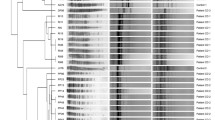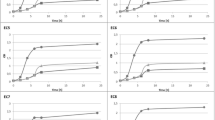Abstract
The etiopathogenesis of Crohn’s disease (CD) is still controversial: several genetic, immunologic, and environmental factors, including some bacteria, have been implicated. This study has been devised to assess the involvement of Escherichia coli in CD. Seven E. coli strains were isolated from 14 biopsies obtained from ileocolic ulcers of patients affected by inflammatory bowel disease (IBD), including six with ulcerative colitis and eight with CD. Five strains, exclusively isolated from CD patients, were found inside mucosal cells. Different PCR techniques (for chuA, yjaA, TspE4.C2, escV, and bfpB genes) were performed and PFGE was carried out to characterize these bacteria in comparison with other E. coli strains isolated from non-IBD specimens. The correlation of these characters with bacterial invasiveness on intestinal (Caco-2) and phagocytic (U937) cells was assessed. Overall our pilot data suggest that five among eight strains isolated from CD patients belonged to the adherent-invasive E. coli (AIEC) group, and were invasive on Caco-2 cells and resistant to phagocytosis. These findings suggest that these bacteria could be considered target organisms whose elimination could reduce the intestinal inflammatory process and CD progression.



Similar content being viewed by others
References
Abubakar I, Myhill D, Aliyu SH, Hunter PR (2008) Detection of Mycobacterium avium subsp. paratuberculosis from patients with Crohn’s disease using nucleic acid-based techniques: a systematic review and meta-analysis. Inflam Bowel Dis 14:401–410
Barnich N, Darfeuille-Michaud A (2007) Role of bacteria in the etiopathogenesis of inflammatory bowel disease. World J Gastroenterol 13:5571–5576
Baumgart DC, Carding SR (2007) Inflammatory bowel disease: cause and immunobiology. Lancet 369:1627–1640
Baumgart M, Dogan B, Rishniw M, Weitzman G, Bosworth B, Yantiss R, Orsi RH, Wiedemann M et al (2007) Culture independent analysis of ileal mucosa reveals a selective increase in invasive Escherichia coli of novel phylogeny relative to depletion of Clostridiales in Crohn’s disease involving the ileum. ISME J 1:403–418
Boudeau J, Glasser A, Masseret E, Joly B, Darfeuille-Michaud A (1999) Invasive ability of an Escherichia coli strain isolated from the ileal mucosa of a patient with Crohn’s disease. Infect Immun 67:4499–4509
Bulois P, Desreumaux P, Neut C, Darfeuille-Michaud A, Cortot A, Colombel JF (1999) Infectious agents and Crohn’s disease. Clin Microbiol Infect 5:601–604
CDCPulseNetUSA (2004) One-day (24–28 h) standardized laboratory protocol for molecular subtyping of Escherichia coli O157:H7, non-typhoidal Salmonella serotypes, and Shigella sonnei by pulsed field gel electrophoresis (PFGE). PulseNet PFGE Manual 5.1–5.3:1–13
Clermont O, Bonacorsi S, Bingen E (2000) Rapid and simple determination of the Escherichia coli phylogenetic group. Appl Environ Microbiol 66:4555–4558
Darfeuille-Michaud A, Neut C, Barnich N, Lederman E, Di Martino P, Desremaux P, Gambiez L, Joly B, Cortot A, Colombel JF (1998) Presence of adherent Escherichia coli strains in ileal mucosa of patients with Crohn’s disease. Gastroenterology 115:1405–1413
Darfeuille-Michaud A, Boudeau J, Bulois P, Neut C, Glasser A-L, Barnich N, Bringer MA, Swidsinski A, Beaugerie L, Colombel JF (2004) High prevalence of adherent-invasive Escherichia coli associated with ileal mucosa in Crohn’s disease. Gastroenterology 127:412–421
De Hertogh G, Aerssens J, Geboes KP, Geboes K (2008) Evidence for the involvement of infectious agents in the pathogenesis of Crohn’s disease. World J Gastroenterol 14:845–852
Dice L (1945) Measures of the amount of ecological association between species. Ecology (New York) 26:297–302
El-Zaatari FA, Naser SA, Hulten K, Burch P, Graham DY (1999) Characterization of Mycobacterium paratuberculosis p36 antigen and its seroreactivities in Crohn’s disease. Curr Microbiol 39:115–119
Fellermann K, Wehkamp J, Herrlinger KR, Stange EF (2003) Crohn’s disease: a defensing deficiency syndrome. Eur J Gastroenterol Hepatol 15:627–634
Gaia E, Pais P, Salacone P, Morello C (2008) Preliminary results obtained with cefoperazone plus corticosteroids in the treatment of active Crohn’s disease. Inflamm Bowel Dis 15:1123–1124
Hanauer SB (2006) Inflammatory bowel disease: epidemiology, pathogenesis, and therapeutic opportunities. Inflam Bowel Dis 12(Suppl 1):S3–S9
Kotlowski R, Bernstein CN, Sepehri S, Krause DO (2007) High prevalence of Escherichia coli belonging to the B2 + D phylogenetic group in inflammatory bowel disease. Gut 56:669–675
La Ferla K, Seegert D, Schreiber S (2004) Activation of NF-kappa B in intestinal epithelial cells by E. coli strains isolated from the colonic mucosa of IBD patients. Int J Colorectal Dis 19:334–342
Lapaquette P, Glasser AL, Huett A, Xavier RJ, Darfeuille-Michaud A (2010) Crohn’s disease-associated adherent-invasive E. coli are selectively favoured by impaired autophagy to replicate intracellularly. Cell Microbiol 12:99–113
Loftus EV Jr (2004) Clinical epidemiology of inflammatory bowel disease: incidence, prevalence, and environmental influences. Gastroenterology 126:1504–1517
Martin HM, Campbell BJ, Hart CA, Mpofu C, Nayar M, Singh R, Englyst H, Williams HF, Rhodes JM (2004) Enhanced Escherichia coli adherence and invasion in Crohn’s disease and colon cancer. Gastroenterology 127:80–93
Martinez-Medina M, Aldeguer X, Lopez-Siles M, Gonzalez-Huix F, Lopez-Oliu C, Dahbi G, Blanco JE, Blanco J, Garcia-Gil LJ, Darfeuille-Michaud A (2009) Molecular diversity of Escherichia coli in the human gut: new ecological evidence supporting the role of adherent-invasive E. coli (AIEC) in Crohn’s disease. Inflam Bowel Dis 15:872–882
Martinez-Medina M, Mora A, Blanco M, Lopez C, Alonso MP, Bonacorsi S, Nicolas-Chanoine MH, Darfeuille-Michaud A, Garcia-Gil J, Blanco J (2009) Similarity and divergence among adherent-invasive E. coli (AIEC) and extraintestinal pathogenic E. coli (ExPEC). J Clin Microbiol 47:3968–3979
Moussata D, Goetz M, Gloeckner A, Kerner M, Campbell B, Hoffman A, Biesterfeld S, Flourie B, Saurin J-C, Galle PR, Neurath MF, Watson AJM, Kiesslich R (2011) Confocal laser endomicroscopy is a new imaging modality for recognition of intramucosal bacteria in onflammatory bowel disease in vivo. Gut 60:26–33
Muller D, Hagedorn P, Brast S, Heusipp G, Bielaszewska M, Friedrich A, Karch H, Schmidt MA (2006) Rapid identification and differentiation of clinical isolates of enteropathogenic Escherichia coli (EPEC), and Shiga toxin-producing Escherichia coli by one-step multiplex PCR method. J Clin Microbiol 44:2626–2629
Naser SA, Ghobrial G, Romero C, Valentine JF (2004) Culture of Mycobacterium avium subsp. paratuberculosis from the blood of patients with Crohn’s disease. Lancet 364:1039–1044
Prantera C, Scribano ML (2009) Antibiotics and probiotics in inflammatory bowel disease: why, when, and how. Curr Opin Gastroenterol 25:329–333
Rachmilewitz D (1989) Coated mesalazine (5-aminosalicylic acid) versus sulphasalazine in the treatment of active ulcerative colitis: a randomized trial. BMJ 298:82–86
Sartor BR (2004) Therapeutic manipulation of the enteric microflora in inflammatory bowel disease: antibiotics, probiotics, and prebiotics. Gastroenterology 126:1620–1633
Sartor RB (2008) Microbial influences in inflammatory bowel disease. Gastroenterology 134:577–594
Sasaki M, Sitaraman SV, Babbin BA (2007) Invasive Escherichia coli are a feature of Crohn’s disease. Lab Investig 87:1042–1154
Sauer A, Moraru CI (2009) Inactivation of Escherichia coli ATCC 25922 and Escherichia coli O157:H7 in apple juice and apple cider, using pulsed light treatment. J Food Prot 72:937–944
Sepehri S, Khafipour E, Bernstein CN, Coombes BK, Pilar AV, Karmali M, Ziebell K, Krause DO (2010) Characterization of Escherichia coli isolated from gut biopsies of newly diagnosed patients with inflammatory bowel disease. Inflamm Bowel Dis 11:22–33. doi:10.1002/ibd.21509
Strober W, Fuss I, Mannon P (2008) The fundamental basis of inflammatory bowel disease. J Clin Invest 117:514–521
Tennant S, Tauschek M, Azzopardi K, Bigham A, Bennett-Wood V, Hartland EL, Whittam TS, Robins-Browne RM (2009) Characterization of atypical enteropathogenic E. coli strains of clinical origin. BMC Microbiol 9:117–128
Tenover FC, Arbeit RD, Goering RV, Mickelsen P, Murray B, Persing DH, Swaminathan B (1995) Interpreting chromosomal DNA restriction patterns produced by pulse-field gel electrophoresis: criteria for bacterial strain typing. J Clin Microbiol 33:2233–2239
Willing B, Halfvarson J, Dicksved J, Rosenquist M, Jarnerot G, Engstrand L, Tysk C, Jansson JK (2009) Twin studies reveal specific imbalances in the mucosa-associated microbiota of patients with ileal Crohn’s disease. Inflamm Bowel Dis 15:653–660
Wine E, Ossa JC, Gray-Owen SD, Sherman PM (2009) Adherent-invasive Escherichia coli, strain LF82 disrupts apical junctional complexes in polarized epithelia. BMC Microbiol 9:180–191
Wine E, Ossa JC, Gray-Owen SD, Sherman PM (2010) Adherent-invasive Escherichia coli target the epithelium barrier. Gut Microbes 1:80–84
Acknowledgment
This study was partly supported by a grant from Piedmont Region (2008 bis).
Author information
Authors and Affiliations
Corresponding author
Rights and permissions
About this article
Cite this article
Raso, T., Crivellaro, S., Chirillo, M.G. et al. Analysis of Escherichia coli Isolated from Patients Affected by Crohn’s Disease. Curr Microbiol 63, 131–137 (2011). https://doi.org/10.1007/s00284-011-9947-8
Received:
Accepted:
Published:
Issue Date:
DOI: https://doi.org/10.1007/s00284-011-9947-8




